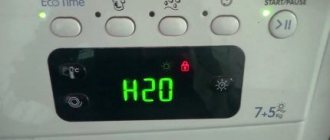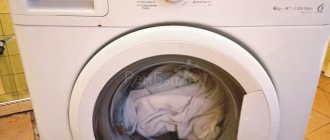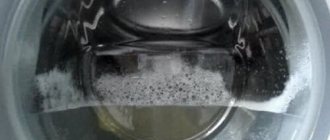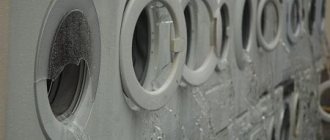Most owners are sure that it is impossible to repair large household appliances without the help of qualified technicians; for example, it is unlikely that they will be able to find out why the dishwasher does not fill with water or the causes of the problem. This is partly true - only specialists can handle complex damage.
Before you start repairing your dishwasher, read this article
In this article we will tell you how to localize and eliminate one of the common malfunctions of a dishwasher (hereinafter also referred to as PMM, dishwasher) without resorting to the services of a technician.
Preventing the problem from recurring
To prevent the problem from reoccurring, you should follow simple rules:
Maintain the device according to the regulations.- Install the dishwasher correctly.
- Clean filters on time.
- Check the condition of the hoses and avoid kinks.
- Install a voltage stabilizer to avoid power surges, which can be dangerous for any household appliance.
Find out everything you need to know about dishwasher water in this section.
Water does not flow into Bosch PMM: reasons
The quality of assembly of equipment by the German corporation Bosch is known throughout Europe and beyond. But even the most reliable household appliances are not immune to failures. Often, the majority of problems are caused by violation of operating rules, incorrect installation, power surges, etc. Therefore, manufacturers have nothing to do with most breakdowns. Analyzing the real reasons why there is no water supply to the Bosch dishwasher, we note the following points:
- There is no water or insufficient pressure in the water pipe.
- The valve is closed, which is why the system does not supply water to the PMM.
- The inlet hose is kinked or pinched.
- The Aquastop system worked, causing the water intake to be blocked.
- A power surge caused the solenoid start valve to fail.
- The hopper door is not closed tightly enough, which is often accompanied by a flashing liquid supply indicator.
- Level sensor failure. In the event of a failure, the sensor transmits incorrect data to the module, which is why water is not poured into the system.
- The filter screen installed on the inlet valve is clogged. The fastest way to solve the problem is to simply remove and wash the filter mesh.
- Failure of an electronic unit is a rare and complex breakdown that practically excludes self-repair.
Important! Do not try to find the cause of the module failure yourself: repairing it is the task of specialists. You will need a special tool and certain skills.
The electronic module has failed
For the convenience of housewives, the following brands of manufacturers have been developed: Electrolux dishwasher; dishwasher Siemens and other companies.
The difference between these devices lies in technical parameters: dimensions, compactness, class, energy consumption, functional modes. Without taking into account the difference in technical parameters, the functionality is similar. Due to the similarity of the operating principle, the causes of the malfunction due to which water does not fill the dishwasher chamber with liquid are similar.
Common causes of dishwasher failure are malfunctions of the electronic module control system. With such a malfunction (regardless of the model, be it Electrolux, Siemens, etc.), the mechanism does not fill the water entering the dishwasher chamber or the electric motor hums, and when it hums and does not take in liquid, the cause is a malfunction of the electronic module. When replacing an electronic unit, a new module must be installed.
When purchasing a new module, you must read the instructions included with the equipment. The module markings are indicated there.
Let's look into it in detail
If there is no water in the water supply, then you need to be more careful and read the warnings on the notice board in front of your entrance - the Housing Office always warns residents about possible water outages due to maintenance work. It is not difficult to check whether the water supply tap to the dishwasher is open and the condition of the inlet hose; however, it is not difficult to determine whether the aqua-stop has worked or not.
Inlet valve
This part is available on absolutely all brands and models of dishwashing machines. If it is faulty, then water will not be drawn into the unit’s system, because the valve will not be able to open access to the inlet hose.
Voltage drops constantly occur in the city electrical network, so excess voltage may be supplied to the electromagnet winding, causing it to burn out. If the winding is faulty, then the signal does not arrive at the rod, and the elastic rubber membrane continues to block the input.
This product cannot be repaired - it needs to be replaced. If you do not understand anything about the technical features of household appliances, then it is better to invite a technician from the service center.
Important! When replacing the solenoid inlet valve yourself, remember that it must match the brand and model number of the dishwasher.
Many home craftsmen successfully and without problems cope with such a replacement and save the family budget.
Loading door
As long as it is not closed tightly, the machine will not work. You need to press it until you hear a characteristic click; if even after that the water intake does not start, then the reason is in the blocking system. What to do in this case? First of all, do not panic, unplug the machine and carefully inspect all the door elements:
- deformation, even the slightest, of the sealing rubber always leads to the door not closing tightly;
- we inspect the lock - if faults are found, we replace it or repair it;
- we check the installation of baskets and containers - if installed incorrectly, they prevent the door from closing tightly;
- If the machine is not level, the door may not close completely due to extraneous interference.
If the reason for the loose closure is a lock, then you can replace it yourself, just purchase a new lock specifically for your model in advance. The lock replacement algorithm is quite simple:
- Open the door and unscrew the fastening screws. Carefully! The edges of the stainless steel coating on the inside are very sharp - do not cut your hands. Hold the top panel so that it does not fall out.
- Carefully disconnect the wire connection terminal.
- Unscrew the fasteners on the top and move the lock to the side.
- We install the new one in place and connect the terminal.
- We insert the top panel into place and tighten the fasteners.
The replacement was successful, now we need to install a new latch so that all the parts are new. The master in this video will explain how to do this.
Some home craftsmen, in order to save money, repair a faulty lock by replacing broken plastic parts with more durable ones made of stainless metal. No one gives a guarantee that such a lock will work longer than the factory one, so why waste energy and reinvent the wheel?
Cleaning the filter
Quite often, the dishwasher does not draw water precisely because the mesh filter is clogged, because the water is hard and its deposits clog the mesh of the filter element. We do everything ourselves:
- close the tap, disconnect the inlet hose from the machine;
- at the connection point, there is a small filter inside - take it out and rinse it under running water;
- if the mesh is very clogged, you can immerse it in citric acid for half an hour.
Then we put everything in its place and try to draw water, everything works - the repair is completed.
Decoding errors
All dishwasher models have a self-diagnosis program. It protects the device from serious damage. In critical situations, an error code appears on the electronic display; the meaning of each is given in the operating instructions.
In any models, errors are grouped into categories:
- malfunctions of drainage and water supply;
- deviations in the water heating process;
- malfunctions of water sensors and switches;
- electrical problems.
The instructions for each error code contain a description of the probable malfunction and how to eliminate it. In the table of malfunctions of BOSCH models.
| Code | Decoding |
| E27/F27 | There was a power surge |
| E22/F22 | The filter is clogged |
| E01/F01 | Problems with the electronic unit |
| E3/F3 | No water coming in |
| E15/F15 | The leakage protection system has activated |
| E09/F09 | The heating element does not work |
| E24/F24 | Waste fluid does not drain |
| E25/F25 |
Watch a video on disassembling a Bosch dishwasher:
Cleaning the filter
If the indicator on the control panel blinks or the machine says “no water,” the cause may be a clogged mesh filter. It becomes clogged with coarse particles and impurities that are ubiquitous in tap water, especially if the machine is connected to a hot pipe. To clean the mesh, follow these guidelines:
- Close the shut-off valve.
- Unscrew the inlet hose by hand.
- There is a small mesh where the hose was screwed in. Carefully remove it with pliers.
- Rinse the filter under the tap.
- If the mesh is severely clogged, soak it for 30–60 minutes in an aqueous solution of citric acid.
- Reassemble everything, connect communications, run a test idle mode to check if the problem is solved.
Control module failure
In principle, any malfunction of the PMM can be reduced to a failure of the electronic module - this element “commands” all processes in the machine. To test a board, you need almost laboratory conditions to test each of its elements. Firmware will be needed for minor problems; in the most severe cases, the board must be replaced.
Tank leak
If your dishwasher fills with water and immediately drains, the problem is most often due to a leak in the machine's tank. When collecting liquid, the bulk of the units control that it does not leak out. The pan of the machine is equipped with leakage sensors. As soon as water gets on the sensor, even in a minimal amount, the machine will stop working or will not start. Units equipped with displays may display error numbers.
You can fix such breakdowns yourself. If the cuff is worn out or the clamps on the pipes are loose, then this can be easily changed with your own hands. If the hoses and pipes are out of order, this can also be fixed with your own hands.
Device structure
Before you figure out why the Bosch dishwasher has problems with water, you need to study how this device works. You should immediately pay attention to the fact that the design of the device is not simple. The manufacturer recommends that you perform only a few steps yourself: cleaning the filters from contamination and additional adjustments. In other cases, it is recommended to contact the service center with all problems. But if the owner of the dishwasher has certain knowledge, then you can try to do the repair yourself. To do this, you need to know on what principle the device works. During one dishwashing cycle, several actions are performed:











